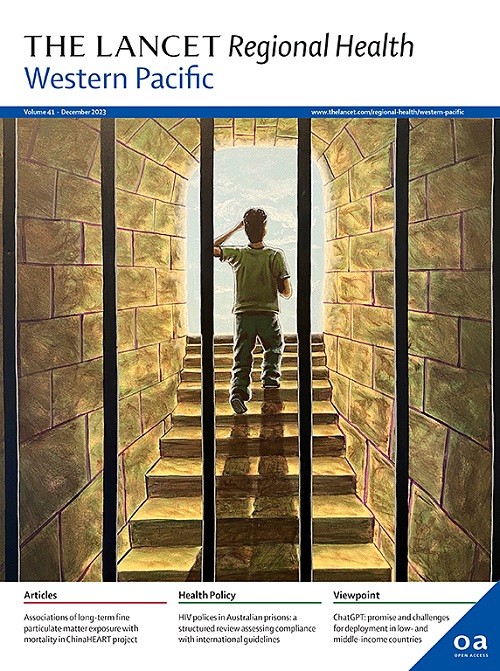将初级卫生保健纳入老年患者出院后的癌症护理——一项实用的非随机对照试验
IF 7.6
1区 医学
Q1 HEALTH CARE SCIENCES & SERVICES
引用次数: 0
摘要
在人口老龄化的推动下,癌症的发病率和存活率不断上升,这对中国的医疗体系提出了重大挑战。癌症患者的管理和随访几乎完全在三级保健中进行,导致服务负担过重。最近的政策指示建议初级卫生保健在癌症治疗中发挥更大的作用,特别是在随访和术后护理方面。与三级医院相比,其优势包括更容易获得服务和更低的自付费用,但三级医院与初级保健中心(PHCs)之间在癌症出院后护理方面的有效协调仍然有限。我们进行了一项实用的试验,将初级保健纳入老年癌症患者的护理中。方法本实用对照试验以中国江苏省南通市的一家三级肿瘤医院为中心,该医院治疗了80%以上的当地癌症患者,涉及6家初级保健医院(1家城市初级保健医院和5家乡镇初级保健医院)作为降级设施。60岁及以上的肺癌、乳腺癌、结直肠癌或前列腺癌患者在住院接受手术、化疗或放疗后由三级医师确诊。参与者根据自己的喜好被分配到常规护理组(由三级医院提供后续护理)或干预组(由三级医生制定和监督后续护理计划,但由初级保健医生提供)。测量的结果是三个月内的住院率、住院时间以及1个月和3个月与健康相关的生活质量(HRQoL)的平均差异。亚组分析调查了不同治疗类型的不同效果。该试验已注册(ChiCTR2300073108)。在2023年5月至2024年4月期间,筛查的1,722名患者中,有755名患者(平均年龄70.2岁,SD 6.40, 276名女性[37%]和479名男性[63%])入组。90名参与者被分配到干预组,665名参与者被分配到常规护理组。干预组患者的家庭收入明显较低。干预组患者1个月时三级医院入院率减少43% (IRR = 0.57, 95% CI: 0.41-0.81, p = 0.001), 3个月时无显著差异(IRR = 0.96, 95% CI: 0.78-1.18, p = 0.705)。与接受手术的对照组患者相比,干预组接受手术的患者在一个月内住院率降低了83% (IRR = 0.17, 95% CI: 0.04-0.76, p = 0.020),在三个月时住院率降低了61% (IRR = 0.39, 95% CI: 0.18-0.82, p = 0.014)。与对照组相比,干预组患者1个月内住院天数减少4.68天(95% CI: -7.92 ~ -1.44, p = 0.005), 3个月内住院天数减少4.26天(95% CI: -8.47 ~ -0.06, p = 0.047)。干预组患者在1个月和3个月时HRQoL更好,3个月时调整后HRQoL显著高于对照组(平均差异= 0.05,95% CI: 0.01 ~ 0.08)。该模型将初级保健整合到出院后的癌症护理中,显著降低了总体住院率,同时提高了生活质量,减少了三级保健的不当使用。需要随机对照试验来进一步探索PHCs整合到癌症治疗中的益处。本文章由计算机程序翻译,如有差异,请以英文原文为准。
Integrating primary healthcare into cancer aftercare for older patients post discharge – a pragmatic non-randomized controlled trial
Background
The increasing incidence and survival rates of cancers, driven by an ageing population, present a significant challenge to China’s healthcare system. Patients with cancer are managed and followed-up almost exclusively within tertiary care with resulting overburdened services. Recent policy directives recommend that primary healthcare adopt an expanded role in cancer care, especially in follow-up and aftercare. Advantages include easier access and lower out-of-pocket costs compared to tertiary hospitals, but effective coordination between tertiary hospitals and primary healthcare centres (PHCs) for post-discharge cancer care remains limited. We conducted a pragmatic trial integrating PHCs into aftercare of older cancer patients.
Methods
This pragmatic controlled trial was centred at a tertiary oncology hospital in Nantong, Jiangsu province, China, which treats over 80% of local cancer patients, and involved six PHCs —one urban PHC and five township hospitals—serving as step-down facilities. Patients aged 60 and older with lung, breast, colorectal, or prostate cancer were identified by tertiary physicians after hospitalization for surgery, chemotherapy, or radiotherapy. Participants were assigned according to their preference, to either the usual care group, with aftercare from the tertiary hospital, or the intervention group, where the follow-up and aftercare plan was developed and monitored by tertiary physicians, but delivered by PHC doctors. Outcomes measured were hospital admissions within three months, length of hospital stay, and the mean difference in health-related quality of life (HRQoL) at one - and three - months. Subgroup analyses investigated differential effects by treatment types. This trial was registered (ChiCTR2300073108).
Findings
Of the 1,722 individuals screened, 755 patients (mean age 70.2years, SD 6.40, 276 females [37%] and 479 males [63%]) were enrolled between May 2023 and April 2024. Ninety participants were assigned to the intervention group and 665 to the usual care group. Patients in the intervention group had significantly lower household incomes. Intervention group patients had 43% fewer admissions to tertiary hospital at one-month (IRR = 0.57, 95% CI: 0.41–0.81, p = 0.001), with no significant difference at three months (IRR = 0.96, 95% CI: 0.78–1.18, p = 0.705). Patients who underwent surgery in the intervention group, had an 83% reduction in hospitalizations at one-month (IRR = 0.17, 95% CI: 0.04–0.76, p = 0.020) and a 61% reduction at three months (IRR = 0.39, 95% CI: 0.18–0.82, p = 0.014), compared to control patients who received surgery. Patients in the intervention group had 4.68 fewer admission days within one-month (95% CI: -7.92 to -1.44, p = 0.005) and 4.26 fewer days within three months (95% CI: -8.47 to -0.06, p = 0.047) compared to the control group. Intervention group patients showed better HRQoL, at one month and three months, with a significantly higher adjusted HRQoL at three months (mean difference = 0.05, 95% CI: 0.01 to 0.08).
Interpretation
The model integrating PHCs into post-discharge cancer care significantly reduced overall hospitalizations while improving quality of life and reduced inappropriate use of tertiary care. Randomized controlled trials are needed to further explore benefits of PHCs integration into cancer care.
求助全文
通过发布文献求助,成功后即可免费获取论文全文。
去求助
来源期刊

The Lancet Regional Health: Western Pacific
Medicine-Pediatrics, Perinatology and Child Health
CiteScore
8.80
自引率
2.80%
发文量
305
审稿时长
11 weeks
期刊介绍:
The Lancet Regional Health – Western Pacific, a gold open access journal, is an integral part of The Lancet's global initiative advocating for healthcare quality and access worldwide. It aims to advance clinical practice and health policy in the Western Pacific region, contributing to enhanced health outcomes. The journal publishes high-quality original research shedding light on clinical practice and health policy in the region. It also includes reviews, commentaries, and opinion pieces covering diverse regional health topics, such as infectious diseases, non-communicable diseases, child and adolescent health, maternal and reproductive health, aging health, mental health, the health workforce and systems, and health policy.
 求助内容:
求助内容: 应助结果提醒方式:
应助结果提醒方式:


